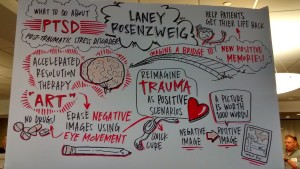This Voter Has No Use for Nostalgia—He Prefers Hope
[Editor’s Note:] I read John Engel’s article in the Daily Hampshire Gazette (my local newspaper) and immediately went to his website to ask his permission to reprint. It’s highly topical and speaks so strongly to something that I’ve felt for a long time but never got around to writing about, and that’s why I chose to share it with you. I generally enjoy his column (which you can read at his site—link is at the bottom) but this is the first time I was moved to republish one.—Shel Horowitz, “The Transformpreneur”]
As published in the Daily Hampshire Gazette, October 26, 2016
As the presidential race approaches Election Day, rhetoric – from candidates, pundits and voters alike – has reached a fever pitch. My kids Zoe and Adam, at ages 10 and 7, are befuddled by both the hype and some of the more disturbing messages that have reached their young ears.
Filtering both the extreme and mundane, what continues to hold my attention is one of the election season’s most persistent themes – a steady beat of cries that the country is in disastrous condition and only getting worse. Some voices from this chorus are calling for a return to life as it was in the 1950s.
While I was not alive, let alone a father in the 1950s, my historical understanding of that era provides me with some insight about what my experience of fatherhood might have been like, in that most laudable decade of modern America. Granted, fathers probably were not writing columns about the experience of fatherhood, and since Al Gore had yet to invent the internet there were no Daddy Blogs – or Mommy blogs, for that matter – to peruse on smart phones, while children frolicked on play dates.
But had I been writing such a column in the 1950s, here are some important topics I may, or may not have, considered.
I might have expressed concern over the dangers families faced while traveling in automobiles, since protective child safety seats had not yet been developed and adult seat belts were not yet standard equipment.

Revolutionary as it was, I would not have been writing about the 1955 patent of a cutting edge chemical known as BPA, which for decades thereafter poisoned infants and children through contaminated baby bottles and Sippy cups until the FDA banned its use in these products, in 2012.
While it would have been socially unacceptable, I might have written about the customs of the day that relegated fathers to roles of provider and protector, denying them the opportunity to nurture their children and share equally, with mothers, in domestic chores and homemaking.
I would have been more than remiss, had I not written about the trauma experienced by people of color who were both routinely denied basic civil rights and subjected to extreme violence when trying to simply create a better life for themselves and their children.
I certainly would have written about the plight of women and mothers — and by extension families — who at the time had relatively little political power, limited professional opportunity, and were subject to persistent sexist norms. Though I probably would not have written about the domestic and sexual abuse women experienced because, as a country, we did not even begin seriously addressing these heinous crimes until the 1970s — and later.
And it would have been beyond taboo for me to write a column about the challenges parents faced when helping their gay, lesbian or transgender children triumph over discrimination and intolerance.
So, while I am not immune to experiencing fear-based nostalgia, calls for returning to bygone eras remind me that we humans often yearn for something we don’t have — and even harder for something we fear losing — all the while neglecting to appreciate what we already have gained. And this leaves us ill equipped for the hard and necessary work of identifying goals and actions that will guide us to a future that unites, not divides, us.
So as a father — in 2016 — I both celebrate, and seek to build upon, the gains we have made since the 1950s, regardless of who is president, because for me, hope trumps nostalgia.
John Engel of Florence, Massachusetts (United States) can be reached through his website, https://www.fatherhoodjourney.com




